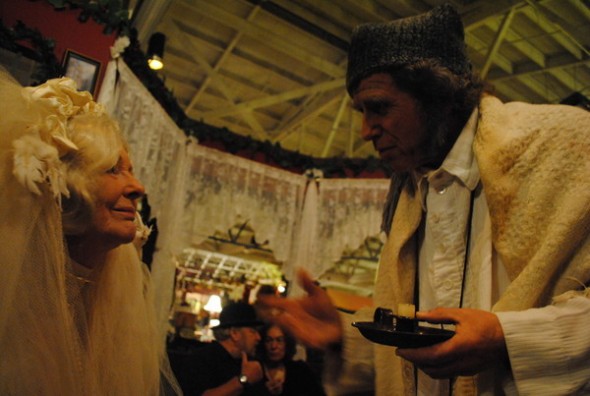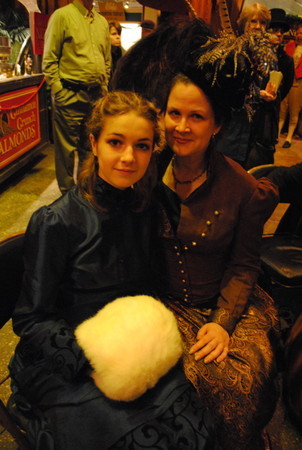This story was published on Dec. 10, 2010 on Half Moon Bay Patch as the first of a two-part series at a look behind the scenes of the Dickens Christmas Fair. It won a third-place prize in the San Francisco Peninsula Press Club’s 2011 Greater Bay Area Awards competition for the “Entertainment” category in the Broadband/Web division.
 The world of Victorian England depicted by Charles Dickens in his many novels was not always bright. Recall some of his most memorable characters: Miss Havisham, pining away in a decaying wedding dress for a man who left her at the altar long ago in Great Expectations; Tiny Tim, a young boy near death whose family cannot pay for his medical treatment in A Christmas Carol; and in the book that bears his name, the orphan Oliver Twist, a child laborer who escapes from his job only to join a juvenile pickpocketing gang run by Fagin and the Artful Dodger.
The world of Victorian England depicted by Charles Dickens in his many novels was not always bright. Recall some of his most memorable characters: Miss Havisham, pining away in a decaying wedding dress for a man who left her at the altar long ago in Great Expectations; Tiny Tim, a young boy near death whose family cannot pay for his medical treatment in A Christmas Carol; and in the book that bears his name, the orphan Oliver Twist, a child laborer who escapes from his job only to join a juvenile pickpocketing gang run by Fagin and the Artful Dodger.
But Dickens penned a fair share of the brighter side of life in his work, most notably when Ebenezer Scrooge realizes the “true” meaning of Christmas is to live his life in the way that imparts the true holiday spirit of giving — which he throws himself into with great aplomb alongside Tiny Tim and the rest of the Cratchit family.
It’s this warm-hearted spirit that is at the center of the world of Victorian England depicted by the Great Dickens Christmas Fair (known more commonly as “The Dickens Fair”) which opened the day after Thanksgiving and is open for two more weekends at Daly City’s Cow Palace.
Part of the Bay Area holiday event calendar since 1970, the Dickens Fair is another creation of the Patterson family from Novato, who started the Bay Area Renaissance Fair in the late 1960s after sponsoring the inaugural event in Los Angeles earlier in the decade.
Visitors who come to the Dickens Fair walk from dull gray skies into a bright, vibrant, three-acre wonderland filled with the rich sights, scents, and sounds one might expect in London during the holiday season. There’s music, dancing, food and drink, browsing (or shopping) galore through the many period stores, games, a puppet show, and interactive street theater with Dickens’ characters and London residents going about daily life.
What should one do first? Well, it depends on the kind of experience you want to have at the fair. One can get down, Victorian-style, at Fezziwig’s Dance Party, a large hall located to the immediate left of the entrance where dozens of couples dressed in the styles of the day dance elegantly to music, navigating around each other with grace.
If you have the gumption, try sending a telegram from the old post office to someone in the festival.
Put your mind to work at the Adventurer’s Club, where lectures, readings, and demonstrations are given throughout the day on topics of interest during the Victorian period.
Get your hair braided in the style of the day with bright ribbons, browse through the antiquarian bookshop, or follow the townspeople as they charge down the streets in protest.
Talk to the people who make up Victorian London as you pass them in the street — whether it be the kid juggling next to the Christmas tree, the society couple walking arm in arm who has paused to listen to some harp music, or the streetsweeper — someone who probably has lots of interesting stories up his sleeve.
And when you’re tired, sit back for some food, be it savory pies, fish and chips, lamb, or a simple sandwich. Have a beer or a drink at the absinthe bar, and enjoy one of the many performances at one of the six stages on site.
Taking in the number of options of things to do and see at the fair is overwhelming, so it’s best to get there early to get the full experience. Every aspect of the fair cries out for attention.
 It’s the elaborate costumes, though, that are the most eye-catching, with women dressed in their most fancy, gussied-up hats accented with feathers and billowing, corseted floor-length dresses made of sumptuous fabric. Most men are nattily dressed in a tall top hat and a dark three-piece suit, while those playing roles of working class residents wear newspaper boy-style caps, worn jackets and faded button down shirts.
It’s the elaborate costumes, though, that are the most eye-catching, with women dressed in their most fancy, gussied-up hats accented with feathers and billowing, corseted floor-length dresses made of sumptuous fabric. Most men are nattily dressed in a tall top hat and a dark three-piece suit, while those playing roles of working class residents wear newspaper boy-style caps, worn jackets and faded button down shirts.
Not all of these modern-day men and women turned weekend Victorian London residents are officially affiliated with the fair; many are visitors. In total, though, there are hundreds of actors playing some role or another as part of the fair. They’re just waiting for you to hear their English accents or talk with them in greater depth at one of the many parlors and social clubs located throughout the fair.
It’s at one of these parlors where Miss Havisham is spending her time on a recent weekend. In her all-white ensemble of crumbled wedding dress, hair and hat, she’s hard to miss.
Miss Havisham (Pacifica resident Surrey Blackburn) explains the work that goes on behind the scenes to make the experience as enchanting as possible for the visitor — in other words, to make him or her believe that the Dickens Fair actually is Victorian England for the time that they are there, based on what they see and hear the actors doing, as well as with their interactions with the actors themselves.
Most actors, like Blackburn, are volunteers. Many have been involved for several years — Blackburn herself has been playing the role of Miss Havisham for nine years. However, unlike most of her peers, Blackburn’s English accent is the real McCoy, which nabbed her the job of teaching Cockney accents to Dickens Fair volunteer actors at Oceana High School in Pacifica for many years.
Blackburn said that those who want to volunteer as actors must take four classes to learn the accents, learn the songs of the period, learn how to dance and sing, know how to put together an authentic period costume, and have an overall understanding of Dickens’ life.
Sounds like a tall order for an American living in the 21st century. But judging from the crowds of actors dressed in their Victorian best who were speaking in English accents that sounded just fine to the untrained American ear — the challenge for them to reinvent themselves was not insurmountable.
Blackburn is part of the division of actors who play out scenes around the fair from Dickens’ many books. While it might appear to the casual visitor that all these scenes unfold quite spontaneously as they encounter each other on the fairgrounds — they are all scheduled and overseen by a different person who is the director of a major Dickens book.
“There’s a director for A Christmas Carol and a director for Oliver Twist,” Blackburn says. “Then there’s one director for all his other books, and under that, there are people who direct each of the books in that category.”
Blackburn is the director of Great Expectations, and she takes her role very seriously. All the major characters are on a tight schedule each day, she says, pulling out a laminated 8.5″ x 11″ schedule from her purse. A quick glance at the schedule is dizzying, as it shows several mini-performances of scenes from the book scheduled for each hour, along with where the scene will be acted out on the grounds and which other characters are part of that scene.
“It’s a 12-hour day,” she said. Blackburn arrives at the fair at 8 or 8:30 a.m. to prepare for the 11 a.m. opening, where she receives notes from her director each day. After the fair ends at 7 p.m., the actors are given feedback and the performances of the day are discussed as a group.
Despite the long hours, Blackburn seems to relish playing the role of Miss Havisham, and has even engineered a few quirky twists to her interactions with visitors.
For example, she said that she gives over 200 small toy mice (the kind that are sold in pet stores for cats) over the course of the fair, which are symbolic of the mice that eat Miss Havisham’s abandoned wedding cake.
She also says that people have told her that they come back to the Dickens Fair year after year just to see Miss Havisham and talk with her.
“As a volunteer, I do it for the love of it,” Blackburn says.
Photos by Kristine A. Wong